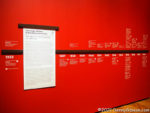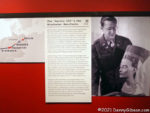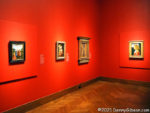 This post’s title is a take-off of the title of an exhibit at the Cincinnati Art Museum the full and accurate title of which is Paintings, Politics and the Monuments Men: The Berlin Masterpieces in America. At the heart of the exhibit is the story of a wildly popular, though somewhat controversial,1948 tour of paintings with its own title: Masterpieces from the Berlin Museums. The tour did not reach Cincinnati although two of the fourteen cities it did reach, Cleveland and Toledo, were in Ohio and there is a major Cincinnati connection.
This post’s title is a take-off of the title of an exhibit at the Cincinnati Art Museum the full and accurate title of which is Paintings, Politics and the Monuments Men: The Berlin Masterpieces in America. At the heart of the exhibit is the story of a wildly popular, though somewhat controversial,1948 tour of paintings with its own title: Masterpieces from the Berlin Museums. The tour did not reach Cincinnati although two of the fourteen cities it did reach, Cleveland and Toledo, were in Ohio and there is a major Cincinnati connection.
 The picture of General Eisenhour looking over some of the paintings that the Nazis had hidden away is at the entrance to the exhibit. On the other side of the wall it is mounted on, there is a timeline of the Nazis’ rise and fall that ends with the Masterpieces from the Berlin Museums tour. Two items from late 1943 are “Allies invade Italy”, in September, and “Monuments, Fine Art, and Archives section (Monuments Men) of the U.S. Army is established”, in December. The Monuments Men (the subject and title of a 2014 movie) set out to locate and protect artworks at risk of being destroyed by the Nazis.
The picture of General Eisenhour looking over some of the paintings that the Nazis had hidden away is at the entrance to the exhibit. On the other side of the wall it is mounted on, there is a timeline of the Nazis’ rise and fall that ends with the Masterpieces from the Berlin Museums tour. Two items from late 1943 are “Allies invade Italy”, in September, and “Monuments, Fine Art, and Archives section (Monuments Men) of the U.S. Army is established”, in December. The Monuments Men (the subject and title of a 2014 movie) set out to locate and protect artworks at risk of being destroyed by the Nazis.


 Thousands of items were located, some in a large salt mine, and brought together at Wiesbaden, Germany. This is where the Cincinnati connection comes in. The director of the Wiesbaden Central Collecting Point was Cincinnatian Walter I. Farmer. By itself, his work in documenting pieces of art and preparing them for return to their owners would have been noteworthy but there was something more.
Thousands of items were located, some in a large salt mine, and brought together at Wiesbaden, Germany. This is where the Cincinnati connection comes in. The director of the Wiesbaden Central Collecting Point was Cincinnatian Walter I. Farmer. By itself, his work in documenting pieces of art and preparing them for return to their owners would have been noteworthy but there was something more.
When he became aware of plans to ship a large number of paintings to the U.S. for safekeeping, Farmer organized thirty-two Monuments Men to produce the Wiesbaden Manifesto which protested what Farmer feared was “spoils of war” type treatment of the European treasures. Smithsonian Magazine calls this “the only act of protest by Army officers against their orders during the entirety of the Second World War”. Although it was eventually published, the manifesto was initially suppressed by Farmer’s superiors. The paintings were shipped to the National Gallery in Washington, DC, and placed in storage. As plans formed to return the paintings to Germany, it was decided to put them on display before their departure. An exhibit at the National Gallery was so popular that the U.S. Congress took notice and actually legislated the tour of thirteen additional museums. All 202 paintings were returned to Germany at the conclusion of the tour.


 Photos of “The Berlin 202” are displayed on a wall near the center of the exhibition. Four of the actual paintings, on loan from the State Museums of Berlin, are on display. The exhibit is fleshed out with other paintings in CAM’s possession by some of the artists contained in the 202. Paintings, Politics and the Monuments Men: The Berlin Masterpieces in America runs through October 3, 2021.
Photos of “The Berlin 202” are displayed on a wall near the center of the exhibition. Four of the actual paintings, on loan from the State Museums of Berlin, are on display. The exhibit is fleshed out with other paintings in CAM’s possession by some of the artists contained in the 202. Paintings, Politics and the Monuments Men: The Berlin Masterpieces in America runs through October 3, 2021.

Interesting, Denny; I knew about the Monuments Men before the movie but never realized the Cincy connection!
I didn’t either. In fact, I knew nothing about the U.S. tour and next to nothing about the written protest. Learning history through art seems to want quite well.